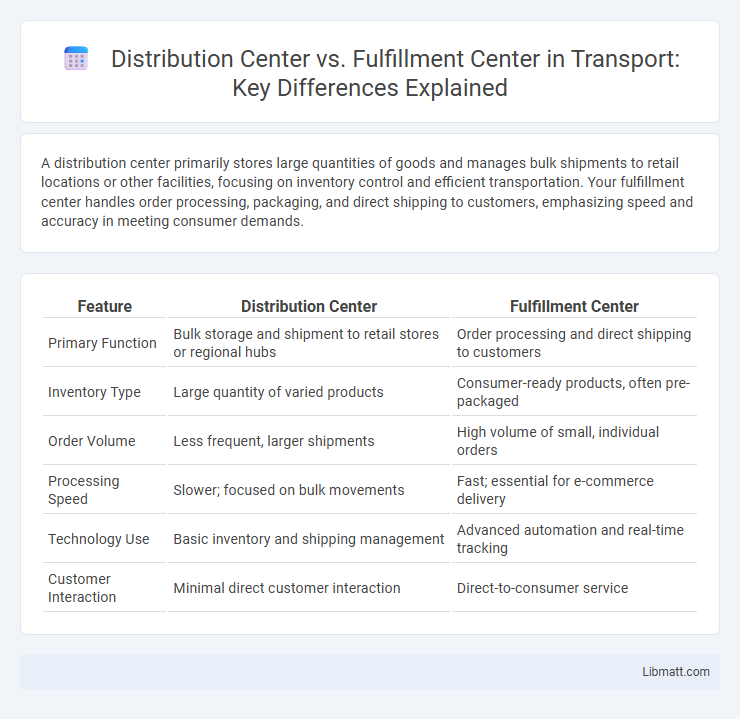A distribution center primarily stores large quantities of goods and manages bulk shipments to retail locations or other facilities, focusing on inventory control and efficient transportation. Your fulfillment center handles order processing, packaging, and direct shipping to customers, emphasizing speed and accuracy in meeting consumer demands.
Table of Comparison
| Feature | Distribution Center | Fulfillment Center |
|---|---|---|
| Primary Function | Bulk storage and shipment to retail stores or regional hubs | Order processing and direct shipping to customers |
| Inventory Type | Large quantity of varied products | Consumer-ready products, often pre-packaged |
| Order Volume | Less frequent, larger shipments | High volume of small, individual orders |
| Processing Speed | Slower; focused on bulk movements | Fast; essential for e-commerce delivery |
| Technology Use | Basic inventory and shipping management | Advanced automation and real-time tracking |
| Customer Interaction | Minimal direct customer interaction | Direct-to-consumer service |
Introduction to Distribution Centers and Fulfillment Centers
Distribution centers are large warehouses designed primarily for storing goods and managing inventory efficiently before products are shipped to retail locations or customers. Fulfillment centers focus on processing customer orders quickly by picking, packing, and shipping products directly to consumers, often supporting e-commerce operations. Both facilities optimize supply chain management but serve distinct roles in inventory storage versus order fulfillment.
Core Functions: Distribution Center vs Fulfillment Center
Distribution centers primarily focus on receiving bulk inventory, storing products, and efficiently moving goods to retail locations or other distribution points. Fulfillment centers specialize in processing individual customer orders by picking, packing, and shipping products directly to consumers. The core function of a distribution center is inventory management and replenishment, while fulfillment centers prioritize order accuracy and rapid delivery.
Inventory Management Differences
Distribution centers primarily focus on bulk storage and shipping large quantities of goods to retail locations or other distribution points, emphasizing inventory turnover and replenishment cycles. Fulfillment centers specialize in handling individual customer orders, requiring precise inventory management systems for real-time stock tracking, order picking, packing, and shipping. Advanced technologies like warehouse management systems (WMS) and real-time data analytics are crucial in fulfillment centers to optimize accuracy and speed in processing diverse SKU orders.
Shipping and Handling Processes
Distribution centers primarily focus on the storage and efficient transportation of bulk inventory to retail locations or other distribution points, optimizing shipping through consolidated shipments and scheduled deliveries. Fulfillment centers specialize in processing individual customer orders, from picking and packing to shipping directly to consumers, ensuring fast and accurate handling for e-commerce demands. Advanced automation and real-time inventory management are integral to both facilities, enhancing shipping accuracy and reducing handling times.
Order Processing Speed and Efficiency
Fulfillment centers prioritize rapid order processing by integrating advanced automation technologies and streamlined workflows, significantly reducing handling times. Distribution centers focus on bulk storage and large-scale inventory management, which can result in slower individual order processing compared to fulfillment centers. Efficiency in fulfillment centers is enhanced through real-time inventory tracking and direct-to-consumer shipping capabilities, optimizing speed for e-commerce orders.
Technological Integration and Automation
Distribution centers utilize advanced warehouse management systems (WMS) to optimize inventory storage and streamline bulk shipping processes, while fulfillment centers integrate sophisticated order management software with automation technologies like robotics and conveyor systems to expedite picking, packing, and shipping for e-commerce. Automation in fulfillment centers enhances real-time order processing and accuracy through AI-driven sorting and barcode scanning, contrasting with distribution centers that focus automation on high-volume pallet handling and cross-docking efficiency. Both facilities leverage IoT devices and data analytics, but fulfillment centers prioritize technology that supports rapid order fulfillment and customer-specific delivery requirements.
Scalability and Flexibility Factors
Distribution centers prioritize large-scale inventory storage and bulk shipping, making them highly scalable for businesses managing extensive product lines and regional demand. Fulfillment centers emphasize flexibility with rapid order processing, customization, and last-mile delivery solutions to efficiently handle fluctuating e-commerce volumes and consumer expectations. Your choice depends on whether scalability for bulk distribution or operational agility for fast fulfillment best supports your logistics strategy.
Cost Considerations for Businesses
Distribution centers typically involve higher operational costs due to large inventory storage, complex logistics, and long-term warehousing expenses. Fulfillment centers emphasize speed and accuracy in order processing, often leading to variable costs based on order volume and shipping requirements. Businesses must evaluate storage fees, labor costs, and shipping efficiency to determine the most cost-effective solution for their supply chain needs.
Ideal Business Use Cases
A distribution center is ideal for businesses managing large inventories and supplying products in bulk to retail locations, ensuring efficient stock replenishment across multiple outlets. A fulfillment center suits e-commerce companies prioritizing fast and accurate order processing directly to customers, optimizing last-mile delivery and customer satisfaction. Your choice depends on whether your business emphasizes wholesale distribution or direct-to-consumer shipping.
Choosing the Right Center for Your Operations
Choosing the right center for your operations depends on the scale and speed of order processing you require. Distribution centers primarily store and manage bulk inventory, optimizing supply chain efficiency for businesses with large, steady stock levels. Fulfillment centers specialize in rapid order picking, packing, and shipping, ideal for e-commerce businesses focusing on fast delivery and customer satisfaction.
distribution center vs fulfillment center Infographic

 libmatt.com
libmatt.com